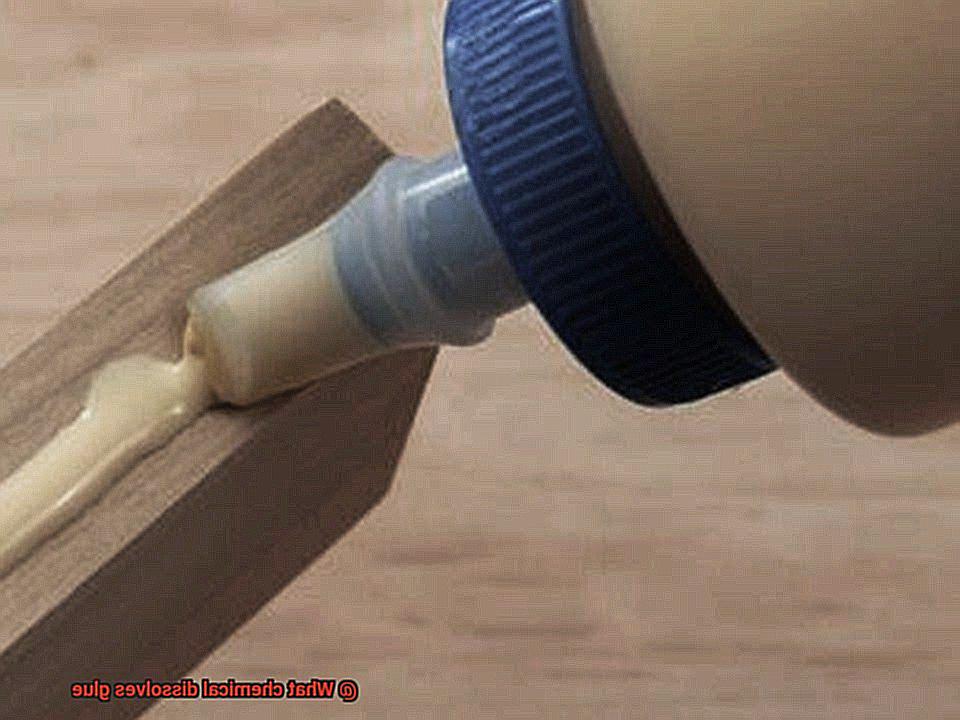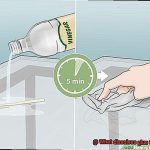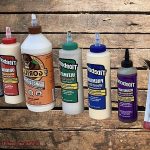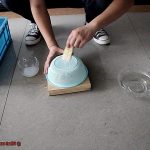Do you know the feeling of frustration when trying to remove a stubborn sticker or label from a surface? It can be like trying to peel off a layer of skin. But don’t worry, there is a solution – chemicals that dissolve glue.
Choosing the right chemical for the job depends on what type of glue you’re dealing with and the surface it’s stuck to. For instance, if you’re trying to remove superglue, acetone will do the trick. And if you want to break down the adhesive properties of labels or stickers, vinegar is your go-to. You might be surprised to learn that even peanut butter can work wonders as a solvent.
Remember though, some chemicals can damage surfaces, so test a small area first before applying it all over. And always follow safety guidelines when using harsh chemicals.
Removing stubborn glue doesn’t have to be a hassle anymore. With the help of these solvents, you’ll be able to get rid of unwanted residue in no time. So next time you find yourself in a sticky situation, reach for the right chemical and wave goodbye to pesky adhesives.
What is Glue?
Contents
- 1 What is Glue?
- 2 Types of Glue
- 3 Common Chemical Solvents for Removing Glue
- 4 Acetone as a Solvent for Removing Glue
- 5 Rubbing Alcohol as a Solvent for Removing Glue
- 6 Mineral Spirits and Paint Thinner as Stronger Solvents for Removing Glue
- 7 Natural Alternatives to Chemical Solvents for Removing Glue
- 8 Conclusion
Glue is more than just a sticky substance used to hold things together. It’s a fascinating chemical composition that has evolved over centuries to become a vital tool in our daily lives. From ancient times to modern-day, glue has come a long way and has been made from various natural and synthetic materials.
Whether you’re repairing a broken vase or building a birdhouse, there’s a type of glue designed specifically for your project. Some are made for woodworking, others for general purposes, and each type has its unique properties and characteristics.
But how does glue actually work? Glue typically consists of a base material that creates the adhesive effect and a solvent that allows it to be easily spread over surfaces. When applied to a surface, the solvent evaporates, leaving behind a sticky substance that adheres to the surface.
The strength of the bond created by glue depends on several factors, such as the type of glue, surface materials, and application method. Additionally, some glues require time to dry and cure fully before reaching their maximum strength.
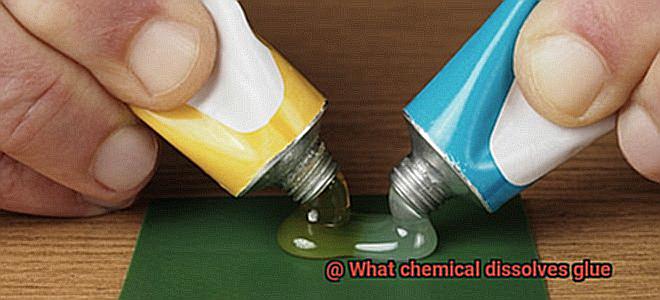
Removing glue can be challenging, but there are several solvents available in the market that make it easier. Acetone and rubbing alcohol are commonly used solvents for removing glue, but tougher jobs may require stronger solvents like mineral spirits or paint thinner.
Types of Glue
Each of these adhesives has its unique properties and uses, making them ideal for specific situations.
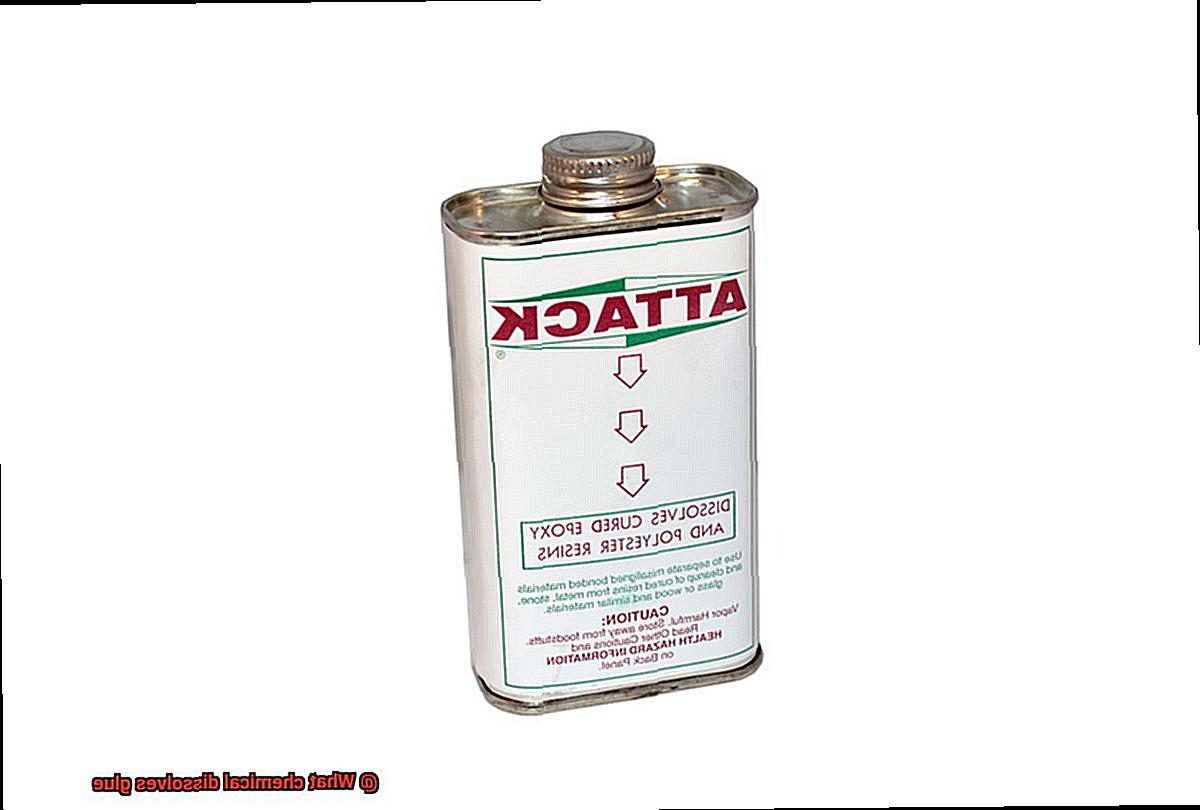
Let’s start with the most commonly known glue, white glue or PVA glue, also referred to as school glue. This glue is water-soluble and dries to a white color, making it perfect for arts and crafts projects.
Next up is superglue, also called cyanoacrylate glue, which forms an almost instant bond and is widely used in industrial applications. However, removing superglue can be challenging, as it requires a specific solvent to dissolve it completely.
Epoxy glue is another popular type of adhesive that creates a strong bond between surfaces. It consists of two parts, a resin and a hardener, that need to be mixed before application. Once cured, it can be challenging to remove without using a chemical solvent.
If you’re into woodworking or packaging, you might have come across hot melt glue. This type of adhesive comes in solid form and requires heat to melt before application. And if you need to remove it, solvents such as rubbing alcohol or acetone can do the trick.
Common Chemical Solvents for Removing Glue
Removing adhesive can be a frustrating chore, but fortunately, there are various chemical solvents available that can make the task a whole lot easier. These solvents work by breaking down the bonds between the glue and the surface it’s stuck to, making it simpler to remove. However, not all solvents are safe for every kind of surface. Therefore, selecting the correct one for the job is crucial.
One of the most popular solvents for removing glue is acetone. You can find this solvent in nail polish remover and is effective at dissolving many types of glue. However, bear in mind that acetone can cause damage to some surfaces such as plastic or painted surfaces. Therefore, it’s best to test it on a small area first. Additionally, use acetone in a well-ventilated area and with gloves to avoid skin irritation.
Another widely used solvent for removing glue is isopropyl alcohol. This solvent is often present in rubbing alcohol and can dissolve many types of glue without damaging most surfaces. But like acetone, it should be used in a well-ventilated area and with gloves to prevent skin irritation.
For more stubborn adhesives such as superglue, you may need a potent solvent like cyanoacrylate remover. This solvent is specifically designed to dissolve superglue and other cyanoacrylate-based adhesives. However, it’s crucial to follow the manufacturer’s instructions carefully when using this solvent.
Some natural methods that may work for removing glue include vinegar and baking soda paste. However, before trying out these methods, research them thoroughly since they may not be safe for all surfaces or types of glue.
Lastly, commercial adhesive removers are also available on the market. These products are specifically designed for removing glue and are usually safe for most surfaces. Be sure to follow the instructions carefully and use them in a well-ventilated area.
Acetone as a Solvent for Removing Glue
Removing glue from surfaces can be a daunting task, but with the right solvent, it can be a breeze. Acetone, a commonly used solvent, is an excellent choice for removing glue because of its ability to dissolve many types of adhesives.
This colorless and flammable liquid is widely available in hardware stores, home improvement centers, and beauty supply shops. It is also used as a solvent in nail polish remover and paint thinner.
When using acetone to remove glue, it is crucial to use it in a well-ventilated area and take precautions to avoid inhaling the fumes.
Acetone should also be kept away from open flames and sparks as it is highly flammable. It is vital to wear protective gloves and goggles to protect your skin and eyes.
To remove glue using acetone, simply apply a small amount of the solvent to a clean cloth or cotton ball and gently rub it onto the adhesive. In most cases, the glue will begin to dissolve, and you can wipe it away with the cloth or cotton ball. For tougher adhesives, you may need to apply multiple applications of acetone or allow the solvent to soak for longer.
Acetone is particularly effective at removing cyanoacrylate-based adhesives, also known as super glue. These types of adhesives bond quickly and strongly, making them difficult to remove with other solvents. Acetone breaks down the chemical bonds in the cyanoacrylate adhesive, allowing it to be removed more easily.
Apart from removing glue, acetone has other practical uses such as cleaning tools and equipment, degreasing surfaces, and removing paint. However, always use acetone with caution and according to manufacturer instructions to avoid any potential hazards.
Rubbing Alcohol as a Solvent for Removing Glue
The solution may be hiding in plain sight – rubbing alcohol.
This colorless and flammable liquid, also known as isopropyl alcohol, is a versatile household item that can be used as a powerful solvent for removing various types of glue. Its strong odor may be off-putting, but its quick evaporation and residue-free finish make it an ideal cleaning agent.
But how does rubbing alcohol work its magic on glue? It’s simple: it breaks down the adhesive properties of the glue, making it easier to wipe away or peel off. This makes it particularly effective for use on hard surfaces such as metal, glass, and plastic.
Using rubbing alcohol as a solvent for removing glue is a breeze. All you need to do is apply it to the affected area using a cotton swab or cloth, let it sit for a few minutes, and then gently rub or scrape away the glue with a plastic scraper or credit card.
However, it’s essential to remember that rubbing alcohol should not be used on delicate surfaces as it may cause damage or discoloration. Additionally, it may not work effectively on all types of glue, such as superglue or epoxy.
Mineral Spirits and Paint Thinner as Stronger Solvents for Removing Glue
These two solvents are commonly used for dissolving adhesives, but what sets them apart?
Mineral spirits are a safe and reliable option for delicate surfaces that may be damaged by stronger chemicals. This milder solvent is less aggressive than paint thinner and has a less potent odor. Plus, it’s less toxic. However, it may require more time and effort to dissolve glue completely.
On the other hand, when it comes to removing even the toughest adhesives, paint thinner is a more powerful solvent. It contains harsher chemicals such as acetone, toluene, and xylene that can emit strong fumes and potentially damage certain materials. It’s important to use protective gear like gloves and respirator masks when handling paint thinner.
Although both solvents are effective at dissolving glue residue, safety precautions are vital when using them. Make sure you’re in a well-ventilated area away from any sources of ignition. It’s also wise to test the solvent on a small area first before applying it more widely.
Natural Alternatives to Chemical Solvents for Removing Glue
Sometimes it can feel like you need a chemical solvent to remove stubborn glue, but these solvents can be harsh and harmful to both you and the environment. Luckily, there are natural alternatives that are safe, effective, and environmentally friendly.
One of the best natural alternatives is vinegar. This mild acid can dissolve the bonds in glue, making it easier to remove. Simply soak a cloth in vinegar and place it over the area with glue. Leave it on for a few hours or overnight, then gently scrape away the softened glue.
Another option is baking soda. This gentle abrasive can help loosen glue from surfaces. Mix equal parts baking soda and water to make a paste, then apply it to the area with glue. After letting it sit for several hours or overnight, gently scrape away the softened glue.
Citrus-based solvents are another great choice for removing glue naturally. These solvents are made from citrus peels and contain natural oils that dissolve adhesives. Not only are they generally safe to use, but they also smell great. Simply apply the solvent to the area with glue and let it sit for several minutes before wiping away.
Finally, coconut oil is an excellent natural solvent for removing glue. It contains lauric acid, which can break down adhesive bonds. Apply a small amount of coconut oil to the area with glue and let it sit for a few minutes before wiping away.
Also Read: How To Remove Glue From Stainless Steel?
Conclusion
Don’t let stubborn glue ruin your day. Removing it can be a daunting task, but don’t worry – there are plenty of chemical solvents available to make the job easier. Acetone and rubbing alcohol are popular choices, but for tougher jobs, mineral spirits or paint thinner may be necessary. Remember to choose the right solvent for the surface you’re working on.
But wait, there’s more. Natural alternatives like vinegar, baking soda paste, citrus-based solvents, and coconut oil can also do wonders in removing glue residue safely and effectively.
Just remember to test a small area before going all in with any chemicals – some surfaces may not react well. And always follow safety guidelines when using harsh chemicals.
In conclusion, don’t let pesky adhesives get you down. With these solvents and natural alternatives at your disposal, you’ll be able to remove unwanted residue in no time.

